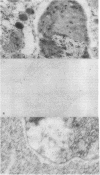Abstract
Previous work showed that hamster and human pancreatic tumors but not normal pancreata exhibit low-affinity cell-membrane receptors for luteinizing hormone-releasing hormone (LHRH). Although the regression of experimental pancreatic cancers induced by treatment with LHRH agonists or antagonists could be explained in part by the creation of sex-steroid deficiency, direct effects mediated by LHRH receptors might also play a role. Here, we demonstrate that pancreatic tumor cells do exhibit high-affinity binding sites for LHRH, but only in their nuclei; low-affinity sites are associated with the cell membranes. These binding sites appear to be LHRH receptors since electron microscopic immunohistochemical studies show that an antibody to the LHRH receptor reacted with sites in the nucleus of pancreatic tumor cells. Immunoreactive sites in the nucleus also were found in a restricted set of normal hamster pituitary cells thought to be luteinizing hormone-secreting cells and in MXT mouse mammary tumor cells. Such nuclear receptors may be involved in the transmission of the direct action of LHRH analogues on the tumor cells, resulting in the enhancement of programmed cell death.
Full text
PDF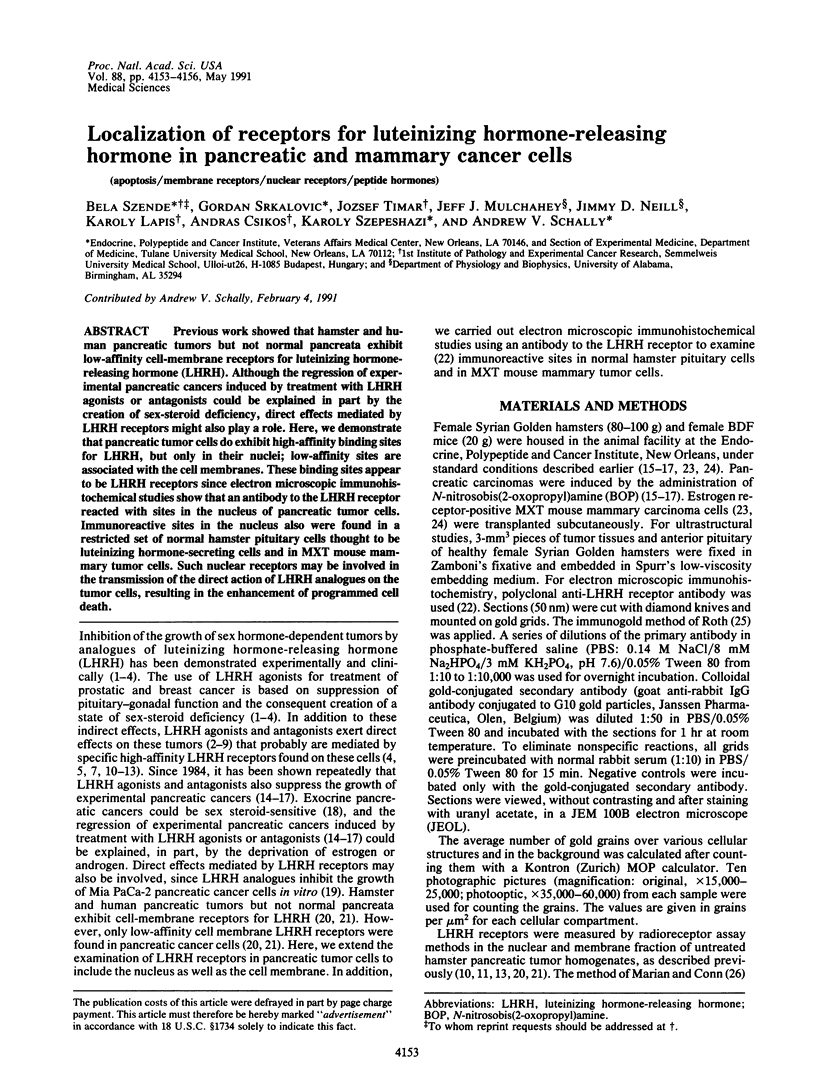
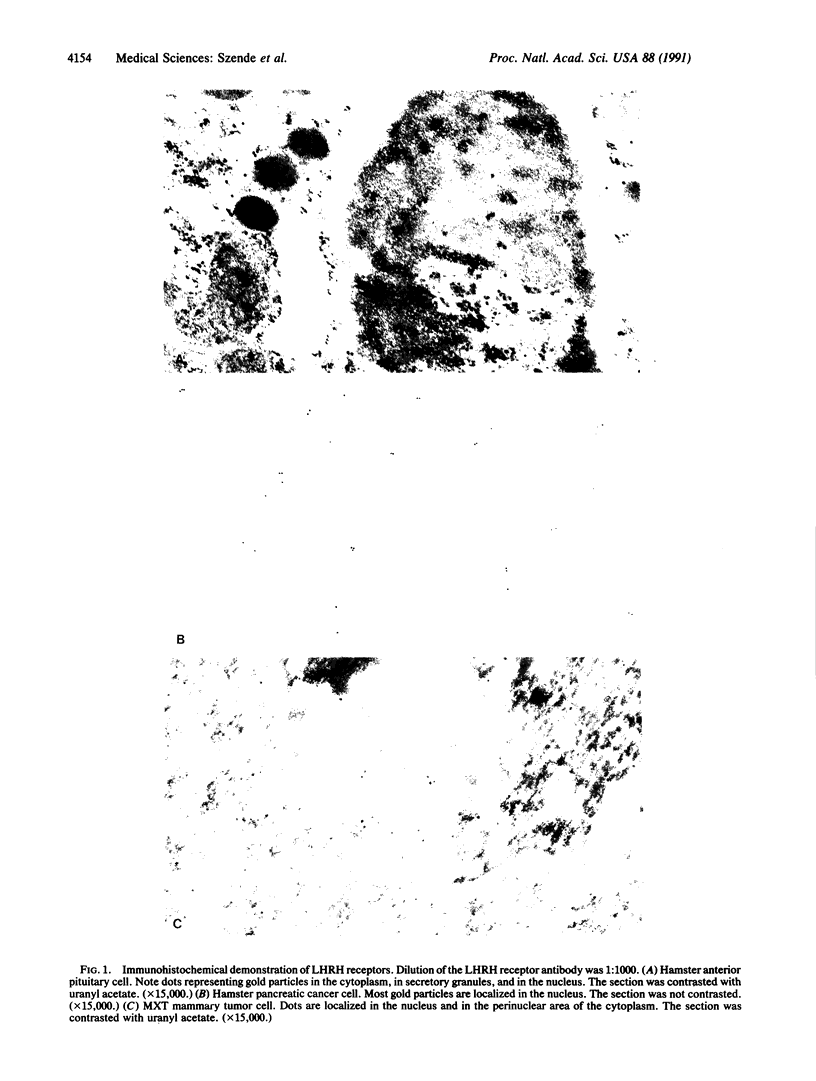
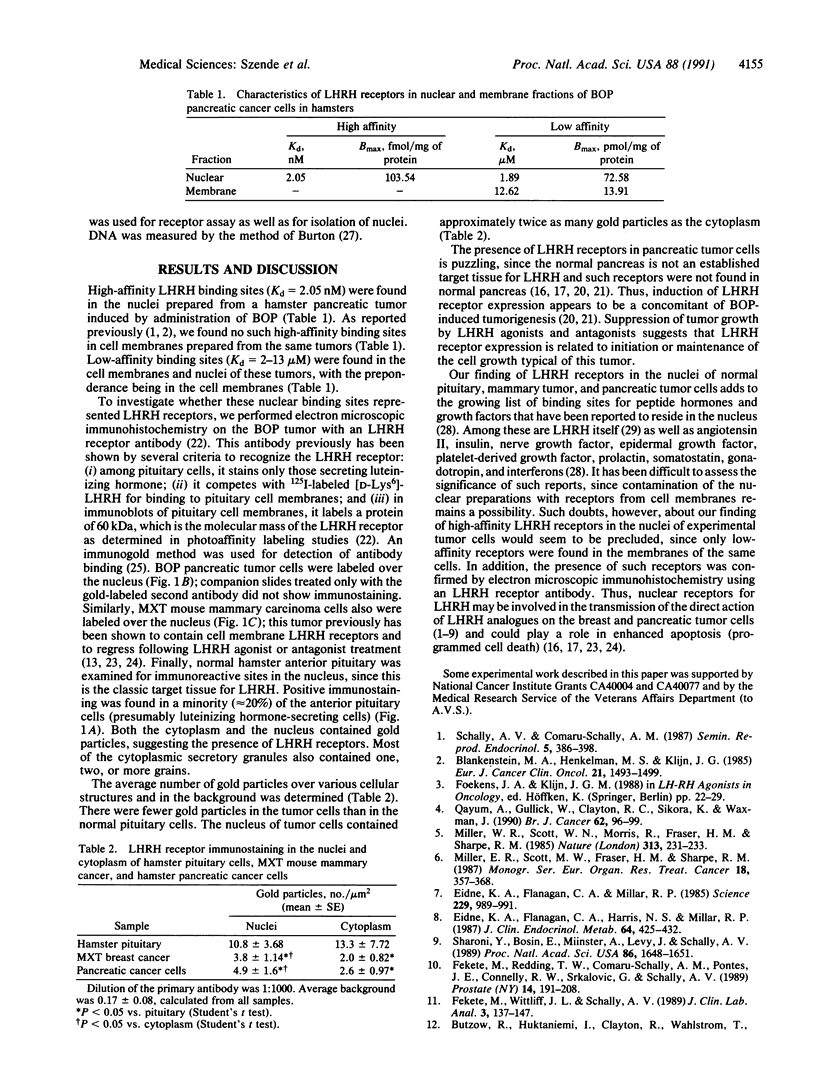
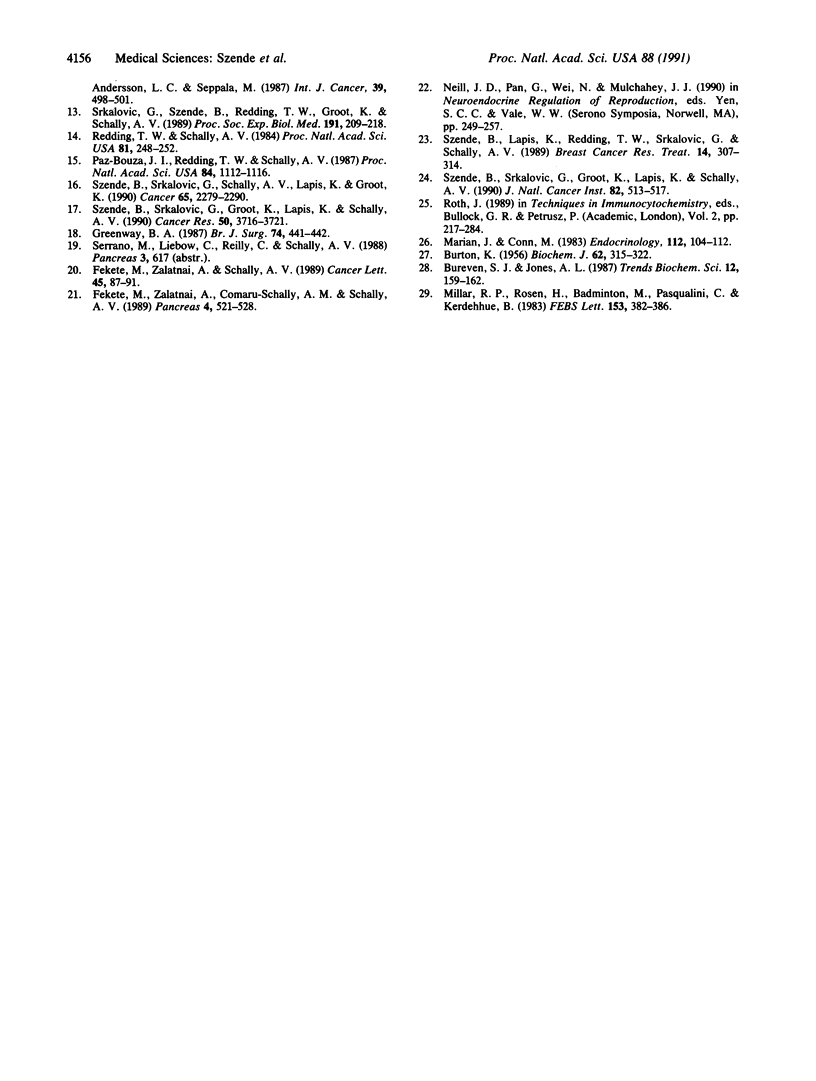
Images in this article
Selected References
These references are in PubMed. This may not be the complete list of references from this article.
- BURTON K. A study of the conditions and mechanism of the diphenylamine reaction for the colorimetric estimation of deoxyribonucleic acid. Biochem J. 1956 Feb;62(2):315–323. doi: 10.1042/bj0620315. [DOI] [PMC free article] [PubMed] [Google Scholar]
- Blankenstein M. A., Henkelman M. S., Klijn J. G. Direct inhibitory effect of a luteinizing hormone-releasing hormone agonist on MCF-7 human breast cancer cells. Eur J Cancer Clin Oncol. 1985 Dec;21(12):1493–1499. doi: 10.1016/0277-5379(85)90244-5. [DOI] [PubMed] [Google Scholar]
- Bützow R., Huhtaniemi I., Clayton R., Wahlström T., Andersson L. C., Seppälä M. Cultured mammary carcinoma cells contain gonadotropin-releasing hormone-like immunoreactivity, GnRH binding sites and chorionic gonadotropin. Int J Cancer. 1987 Apr 15;39(4):498–501. doi: 10.1002/ijc.2910390416. [DOI] [PubMed] [Google Scholar]
- Eidne K. A., Flanagan C. A., Harris N. S., Millar R. P. Gonadotropin-releasing hormone (GnRH)-binding sites in human breast cancer cell lines and inhibitory effects of GnRH antagonists. J Clin Endocrinol Metab. 1987 Mar;64(3):425–432. doi: 10.1210/jcem-64-3-425. [DOI] [PubMed] [Google Scholar]
- Eidne K. A., Flanagan C. A., Millar R. P. Gonadotropin-releasing hormone binding sites in human breast carcinoma. Science. 1985 Sep 6;229(4717):989–991. doi: 10.1126/science.2992093. [DOI] [PubMed] [Google Scholar]
- Fekete M., Redding T. W., Comaru-Schally A. M., Pontes J. E., Connelly R. W., Srkalovic G., Schally A. V. Receptors for luteinizing hormone-releasing hormone, somatostatin, prolactin, and epidermal growth factor in rat and human prostate cancers and in benign prostate hyperplasia. Prostate. 1989;14(3):191–208. doi: 10.1002/pros.2990140302. [DOI] [PubMed] [Google Scholar]
- Fekete M., Wittliff J. L., Schally A. V. Characteristics and distribution of receptors for [D-TRP6]-luteinizing hormone-releasing hormone, somatostatin, epidermal growth factor, and sex steroids in 500 biopsy samples of human breast cancer. J Clin Lab Anal. 1989;3(3):137–147. doi: 10.1002/jcla.1860030302. [DOI] [PubMed] [Google Scholar]
- Fekete M., Zalatnai A., Comaru-Schally A. M., Schally A. V. Membrane receptors for peptides in experimental and human pancreatic cancers. Pancreas. 1989;4(5):521–528. doi: 10.1097/00006676-198910000-00001. [DOI] [PubMed] [Google Scholar]
- Fekete M., Zalatnai A., Schally A. V. Presence of membrane binding sites for [D-TRP6]-luteinizing hormone-releasing hormone in experimental pancreatic cancer. Cancer Lett. 1989 May;45(2):87–91. doi: 10.1016/0304-3835(89)90141-9. [DOI] [PubMed] [Google Scholar]
- Greenway B. A. Carcinoma of the exocrine pancreas: a sex hormone responsive tumour? Br J Surg. 1987 Jun;74(6):441–442. doi: 10.1002/bjs.1800740602. [DOI] [PubMed] [Google Scholar]
- Marian J., Conn P. M. Subcellular localization of the receptor for gonadotropin-releasing hormone in pituitary and ovarian tissue. Endocrinology. 1983 Jan;112(1):104–112. doi: 10.1210/endo-112-1-104. [DOI] [PubMed] [Google Scholar]
- Millar R. P., Rosen H., Badminton M., Pasqualini C., Kerdelhue B. Luteinizing hormone-releasing hormone (LH-RH) binding to purified rat pituitary nuclei. FEBS Lett. 1983 Mar 21;153(2):382–386. doi: 10.1016/0014-5793(83)80648-6. [DOI] [PubMed] [Google Scholar]
- Miller W. R., Scott W. N., Morris R., Fraser H. M., Sharpe R. M. Growth of human breast cancer cells inhibited by a luteinizing hormone-releasing hormone agonist. Nature. 1985 Jan 17;313(5999):231–233. doi: 10.1038/313231a0. [DOI] [PubMed] [Google Scholar]
- Paz-Bouza J. I., Redding T. W., Schally A. V. Treatment of nitrosamine-induced pancreatic tumors in hamsters with analogs of somatostatin and luteinizing hormone-releasing hormone. Proc Natl Acad Sci U S A. 1987 Feb;84(4):1112–1116. doi: 10.1073/pnas.84.4.1112. [DOI] [PMC free article] [PubMed] [Google Scholar]
- Redding T. W., Schally A. V. Inhibition of growth of pancreatic carcinomas in animal models by analogs of hypothalamic hormones. Proc Natl Acad Sci U S A. 1984 Jan;81(1):248–252. doi: 10.1073/pnas.81.1.248. [DOI] [PMC free article] [PubMed] [Google Scholar]
- Sharoni Y., Bosin E., Miinster A., Levy J., Schally A. V. Inhibition of growth of human mammary tumor cells by potent antagonists of luteinizing hormone-releasing hormone. Proc Natl Acad Sci U S A. 1989 Mar;86(5):1648–1651. doi: 10.1073/pnas.86.5.1648. [DOI] [PMC free article] [PubMed] [Google Scholar]
- Srkalovic G., Szende B., Redding T. W., Groot K., Schally A. V. Receptors for D-Trp6-luteinizing hormone-releasing hormone, somatostatin, and insulin-like growth factor I in MXT mouse mammary carcinoma. Proc Soc Exp Biol Med. 1989 Dec;192(3):209–218. doi: 10.3181/00379727-192-42987. [DOI] [PubMed] [Google Scholar]
- Szende B., Lapis K., Redding T. W., Srkalovic G., Schally A. V. Growth inhibition of MXT mammary carcinoma by enhancing programmed cell death (apoptosis) with analogs of LH-RH and somatostatin. Breast Cancer Res Treat. 1989 Dec;14(3):307–314. doi: 10.1007/BF01806302. [DOI] [PubMed] [Google Scholar]
- Szende B., Srkalovic G., Groot K., Lapis K., Schally A. V. Growth inhibition of mouse MXT mammary tumor by the luteinizing hormone-releasing hormone antagonist SB-75. J Natl Cancer Inst. 1990 Mar 21;82(6):513–517. doi: 10.1093/jnci/82.6.513. [DOI] [PubMed] [Google Scholar]
- Szende B., Srkalovic G., Groot K., Lapis K., Schally A. V. Regression of nitrosamine-induced pancreatic cancers in hamsters treated with luteinizing hormone-releasing hormone antagonists or agonists. Cancer Res. 1990 Jun 15;50(12):3716–3721. [PubMed] [Google Scholar]
- Szende B., Srkalovic G., Schally A. V., Lapis K., Groot K. Inhibitory effects of analogs of luteinizing hormone-releasing hormone and somatostatin on pancreatic cancers in hamsters. Events that accompany tumor regression. Cancer. 1990 May 15;65(10):2279–2290. doi: 10.1002/1097-0142(19900515)65:10<2279::aid-cncr2820651020>3.0.co;2-3. [DOI] [PubMed] [Google Scholar]



